 W
WMecoptera are an order of insects in the superorder Endopterygota with about six hundred species in nine families worldwide. Mecopterans are sometimes called scorpionflies after their largest family, Panorpidae, in which the males have enlarged genitals that look similar to the stingers of scorpions, and long beaklike rostra. The Bittacidae, or hangingflies, are another prominent family and are known for their elaborate mating rituals, in which females choose mates based on the quality of gift prey offered to them by the males. A smaller group is the snow scorpionflies, family Boreidae, adults of which are sometimes seen walking on snowfields. In contrast, the majority of species in the order inhabit moist environments in tropical locations.
 W
WAneuretopsychidae is an extinct family of scorpionflies known from the Mesozoic. Fossils are known from the Jurassic (Callovian-Oxfordian) to the early Late Cretaceous (Cenomanian). It is part of Mesopsychoidea, a group of scorpionflies with siphonate proboscis. They are suggested to have been nectarivores, feeding off the liquid pollination drops of and acting as pollinators for now extinct insect pollinated gymnosperms such as Bennettitales.
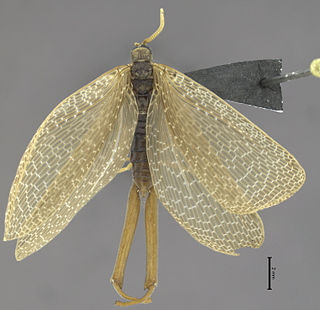 W
WAustromerope is a genus of forcepfly which contains only two known species, Austromerope poultoni from Western Australia, and the South American Austromerope brasiliensis. They are small scorpionflies, with large forceps-like structures at the tail and two pairs of wings. Only adults and eggs from captured adults are known - no larval stage has been seen. Much of the biology of these insects is not known, due to their secretiveness and rarity.
 W
WAustromerope brasiliensis is one of only two living representatives of the genus Austromerope. It is apparently endemic to Brazil, with large forceps-like structures at the tail and two pairs of wings. Only adults are known - no larval stage has been seen.
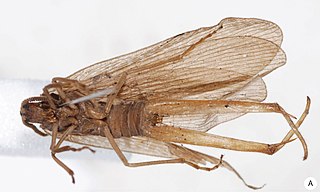 W
WAustromerope poultoni is one of only two representatives of the genus Austromerope, and the only member of the family Meropeidae in the Eastern Hemisphere. It is endemic to Western Australia, typically around 20mm long, with large forceps-like structures at the tail and two pairs of wings. Only adults and eggs from captured adults are known – no larval stage has been seen. It is found in a variety of habitats, including woodland, Jarrah forest, and sand plain vegetation.
 W
WBittacidae is a family of scorpionflies commonly called hangingflies or hanging scorpionflies.
 W
WBittacus is a genus of hangingflies in the order Mecoptera. Members of the genus have a cosmopolitan distribution. The genus has existed since at least the earliest Late Cretaceous. Bittacus is considered "grossly paraphyletic" and serves as a catch-all for many distantly related species of hangingflies.
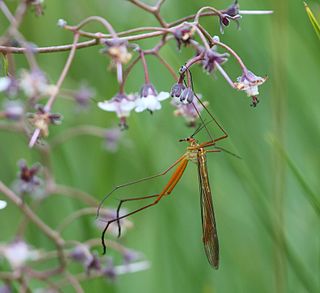 W
WBittacus kimminsi is a species of hangingfly in the family Bittacidae. It is found in the highlands of South Africa. Its favoured habitat is grassland, often near wetlands.
 W
WBittacus strigosus, the striped scorpionfly, is a species of hangingfly in the family Bittacidae. It is found in North America.
 W
WBoreidae, commonly called snow scorpionflies, or in the British Isles, snow fleas are a very small family of scorpionflies, containing only around 30 species, all of which are boreal or high-altitude species in the Northern Hemisphere. Recent research indicates the boreids might be more closely related to fleas than to other scorpionflies, which would render the order Mecoptera paraphyletic if the order Siphonaptera is excluded from it.
 W
WBoreus is the most diverse of three genera of insects in the family Boreidae. They are commonly known as winter scorpionflies due to their close relation to the true scorpionflies and preference for cold habitats.
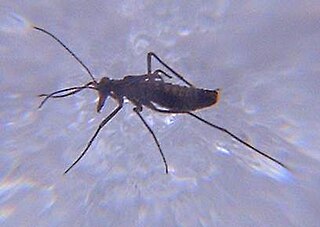 W
WBoreus hyemalis is an insect, 3 to 4.5 millimetres long from the family of Boreidae. Its common name is snow flea.
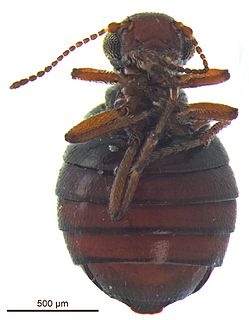 W
WCaurinus is a genus of snow scorpionflies in the family Boreidae. There are at least two described species in Caurinus.
 W
WThe Choristidae are a small family of scorpionflies known only from Australia. Their larvae are found in moss mats.
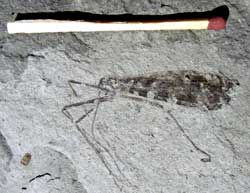 W
WCimbrophlebia is an extinct genus of Mecoptera which existed from the Jurassic to the Eocene period.
 W
WCimbrophlebiidae is an extinct family of scorpionflies. They are considered to be the sister group to the Bittacidae, together forming the clade Raptipedia.
 W
WDinokanaga is a small genus of scorpionfly belonging to the extinct family Dinopanorpidae. The six species D. andersoni, D. dowsonae, D. hillsi, D. sternbergi, D. webbi, and D. wilsoni have all been recovered from Eocene fossil sites in British Columbia, Canada, and Washington state, United States.
 W
WDinopanorpidae is a small family of extinct insects in the order Mecoptera (scorpionflies) that contains two genera and seven species.
 W
WEomeropidae is a family of aberrant, flattened scorpionflies represented today by only a single living species, Notiothauma reedi, known from the Nothofagus forests in southern Chile, while all other recognized genera in the family are known only as fossils, with the earliest definitive fossil known from Liassic-aged strata, and the youngest from Paleogene-aged strata.
 W
WEorpidae is a small family of extinct insects in the scorpionfly order, Mecoptera, which contains a single genus, Eorpa. Three Eocene age species found in Western North America have been placed into the genus: E. elverumi, E. jurgeni, and E. ypsipeda.
 W
WFortiholcorpa paradoxa is an extinct species of scorpionfly (Mecoptera) from the Middle Jurassic of China. It is the only known species of its genus.
 W
WBittacidae is a family of scorpionflies commonly called hangingflies or hanging scorpionflies.
 W
WHarpobittacus is a genus of hangingfly or scorpionfly of the family Bittacidae found in Australia.
 W
WHarpobittacus australis is an Australian species of insect in the family Bittacidae found in the southern states of New South Wales, Victoria, South Australia and Tasmania.
 W
WHarpobittacus septentrionis is a species of insect in the family Bittacidae found on the north-east coast of Australia.
 W
WHylobittacus apicalis is a species of hangingfly in the order Mecoptera, and the only species within the genus Hylobittacus.
 W
WJuracimbrophlebia is an extinct genus of hangingflies that lived during the Middle Jurassic Period about 165 million years ago, containing only its type species, Juracimbrophlebia ginkgofolia; it was discovered in deposits from Daohugou in northeastern China’s Inner Mongolia.
 W
WJurassipanorpa is a genus of fossil scorpionfly containing two species described in 2014 from the Jiulongshan Formation of Inner Mongolia, China. The two species, J. impuctata and J. sticta, lived in the late Middle Jurassic period and represent the oldest known representatives of the scorpionfly family Panorpidae.
 W
WLichnomesopsyche is an extinct genus of mesopsychid mecopteran which existed in what is now China during the middle Jurassic period. It was found in the Daohugou Bed. It was named by Ren Dong, Conrad C. Labandeira and Shih ChungKun in 2010. Three species have been named, which can be distinguished by their differing male genitalia.
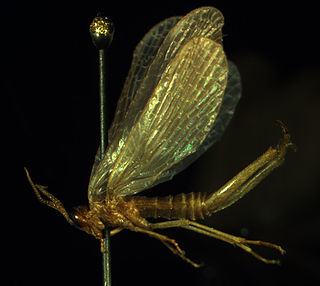 W
WMerope tuber, the earwigfly or forcepfly, is the only species in the genus Merope, and the only living member of the family Meropeidae in North America. It occurs throughout the east from Ontario to Georgia, and west to Kansas. Recently the insect has also been found in Florida. This insect's most distinguishing feature is the segmented cerci on the male abdomen. The function of these is not known, but they may be used during courtship. Much is unknown about the adults, which are nocturnal and secretive, sometimes found under logs or in malaise traps near streams, or attracted to lights at nighttime. No M. tuber or Meropeid larvae have been identified. The insect is characterized by long wings with many veins and no ocelli. There is a region of interlocking sclerites that holds the jugum and scutellum on the middle thoracic segment together. This may be used to keep the wings together when pushing up through dirt. A similar apparatus is found in cicadas and ground-dwelling beetles, so it may be that the winged adults dig in soil. The flat appearance of the insect suggests that the insect dwells close to the ground in fissures and other small ground openings, as does the lack of ocelli.
 W
WMerope tuber, the earwigfly or forcepfly, is the only species in the genus Merope, and the only living member of the family Meropeidae in North America. It occurs throughout the east from Ontario to Georgia, and west to Kansas. Recently the insect has also been found in Florida. This insect's most distinguishing feature is the segmented cerci on the male abdomen. The function of these is not known, but they may be used during courtship. Much is unknown about the adults, which are nocturnal and secretive, sometimes found under logs or in malaise traps near streams, or attracted to lights at nighttime. No M. tuber or Meropeid larvae have been identified. The insect is characterized by long wings with many veins and no ocelli. There is a region of interlocking sclerites that holds the jugum and scutellum on the middle thoracic segment together. This may be used to keep the wings together when pushing up through dirt. A similar apparatus is found in cicadas and ground-dwelling beetles, so it may be that the winged adults dig in soil. The flat appearance of the insect suggests that the insect dwells close to the ground in fissures and other small ground openings, as does the lack of ocelli.
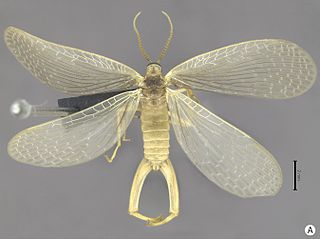 W
WMeropeidae is a family of tiny scorpionflies within the order Mecoptera with only three living species, commonly referred to as "earwigflies". These include the North American Merope tuber, the Western Australian Austromerope poultoni, and the recently discovered South American A. brasiliensis. The biology of these species is essentially unknown, and their larvae have never been seen. The disjunct distribution suggests a common origin before the breakup of the ancient supercontinent of Pangaea. There are two undisputed extinct genera, Boreomerope antiqua known from an isolated wing found in the Middle Jurassic Itat Formation of Siberia and Burmomerope with three species from the Cenomanian aged Burmese amber. As such, the extant members of this family can be considered living fossils. These insects are also of interest due to their presumed basal position in the order Mecoptera. Thaumatomerope with four described species all from the Madygen Formation in Kyrgyzstan has historically sometimes been included within the family, it was placed into its own monotypic family, "Thaumatomeropidae." in 2002.
 W
WMesopsychidae is an extinct family of scorpionflies known from the Late Permian to Mid Cretaceous. It is part of Mesopsychoidea, a group of scorpionflies with siphonate proboscis. They are suggested to have been nectarivores, feeding off the liquid pollination drops and acting as pollinators for now extinct insect pollinated gymnosperms such as Bennettitales.
 W
WMiriholcorpa is an extinct genus of scorpionfly (Mecoptera) from the Middle Jurassic period of China. The type and only species is M. forcipata, described in 2013.
 W
WNotiothauma is the sole living genus in the scorpionfly family Eomeropidae. The genus is monotypic with a lone species Notiothauma reedi which is native to the Valdivian temperate rain forests of central Chile, especially the forests with Nothofagus stands. N. reedi is flattened with a notedly cockroach-like in appearance. They are nocturnal and inhabit the forest floor where the adults feed on plants and decaying animals. The larvae are still unknown. Because this is the last extant species of Eomeropidae, N. reedi can be characterized as a living fossil taxon.
 W
WPanorpa cognata is a species of scorpionfly belonging to the family Panorpidae.
 W
WPanorpa communis, the common scorpionfly, is a species of scorpionfly.
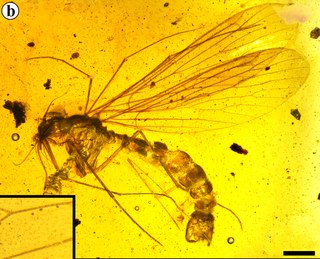 W
WPseudopolycentropodidae is an extinct family of scorpionflies known from the Mesozoic. Fossils are known from the Middle Triassic (Anisian) to the early Late Cretaceous (Cenomanian). It is part of Mesopsychoidea, a group of scorpionflies with siphonate proboscis. They are suggested to have been nectarivores, feeding off the liquid pollination drops and acting as pollinators for now extinct insect pollinated gymnosperms such as Bennettitales.
 W
WBoreidae, commonly called snow scorpionflies, or in the British Isles, snow fleas are a very small family of scorpionflies, containing only around 30 species, all of which are boreal or high-altitude species in the Northern Hemisphere. Recent research indicates the boreids might be more closely related to fleas than to other scorpionflies, which would render the order Mecoptera paraphyletic if the order Siphonaptera is excluded from it.